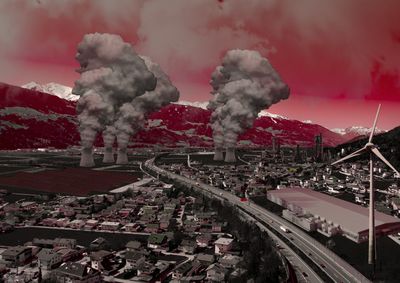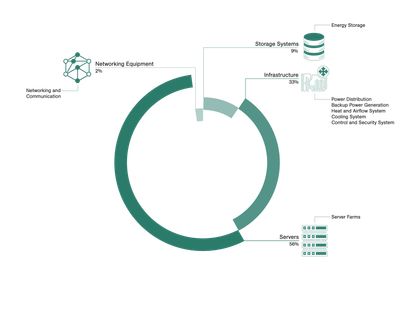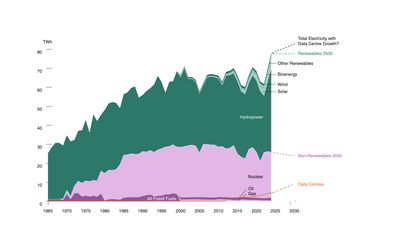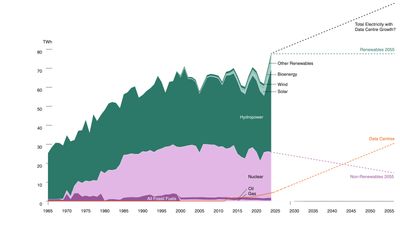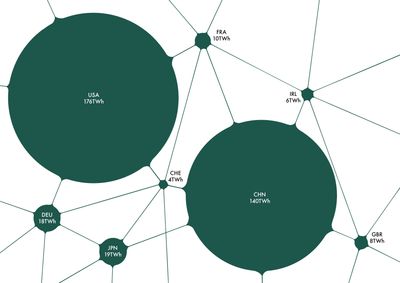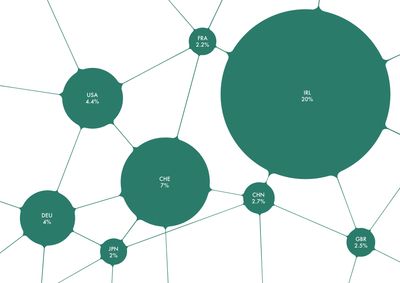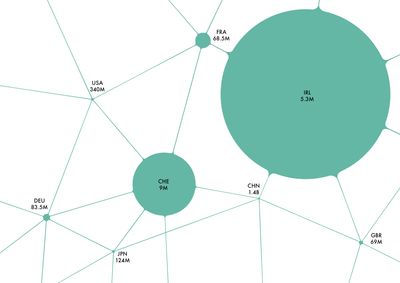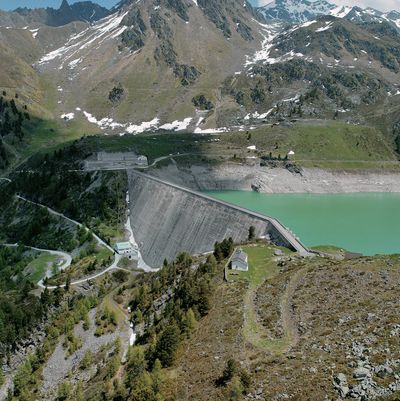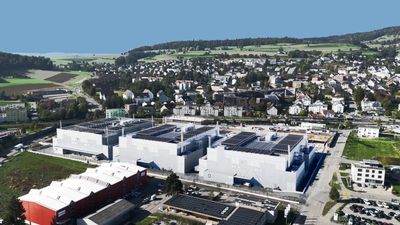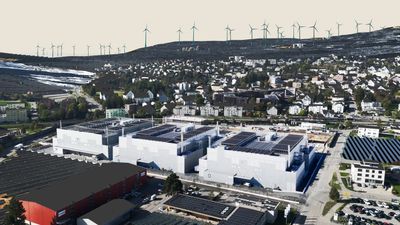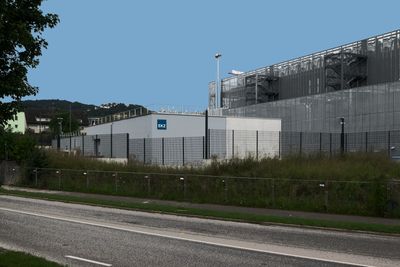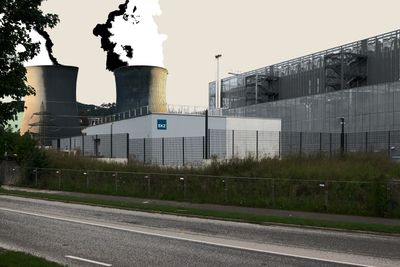AtlasEnergy DemandLoris Gomez, Lucien Peguiron, Adam Chong, and Thierry Fong
With the rise of new technologies and the rapid development of artificial intelligence, our world is becoming increasingly dependent on energy. Every click, every search, every digital interaction requires energy. As our data consumption explodes, so does our energy demand, leading us to extract, burn, and exploit resources at an unprecedented rate.
If we do not act wisely, we may one day wake up in a world that looks disturbingly similar to the image below: a bleak, post-apocalyptic landscape where nature has been replaced by machines, smoke, and silence. This imagined scenery stands as a warning as it reflects the possible consequences of our insatiable appetite for progress and connectivity. The more we innovate, the more energy we consume and the more fragile our planet becomes. How far are we willing to go to sustain our digital lifestyles?
The Power-Hungry Machine
Data centres contain components that all require electricity to run. The pie chart below depicts the share of energy demand by the different components.
Servers
Servers take up the largest share of energy demand with 56 %. They store the plethora of data that is fed into these data centres for safekeeping.
Infrastructure
This consists of equipment for cooling, power distribution, lighting and security, backup batteries and generators. Infrastructure takes up the second highest spot for energy used, especially for cooling, which is significant for servers to run.
Storage Systems
Battery systems that provide electricity instantaneously when there is a delay in the start-up of backup power generation.
Networking Equipment
Taking the lowest share of energy demand, networking equipment includes routers, switches and cabling that help maintain high-bandwidth communication of data.
Switzerland is today among the countries with the highest data centre density per capita globally. The Zurich region sticks out as a location with a high number of data centres with a high enery demand.

Data centres in Switzerland and their energy demands. The size of the cross indicates the energy consumption.
With the rise of technology and the Internet cam the rise of data centres. Switzerland has seen a drastic increase in the number of data centres within its borders, especially from the 21st century, and this number will continue to grow. With plans to build larger and “better” data centres in the near future, data centres are no longer just increasing in number, but also in scale—which will result in an exponential rise in energy demand.
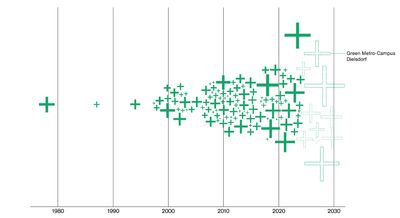
Chart of the construction of data centres in Switzerland over time.
 3 ha
3 ha 0.7 ha
0.7 ha Built
Built Planned
Planned
Switzerland has seen a gradual increase in its total electricity generation since the 1960s, with the share of nuclear-generated electricity rising rapidly around 1970 to roughly equal the output of hydropower since.
In recent decades, renewables other than hydropower, such as solar, wind, or bioenergy have carved out a small slice of the overall electricity output of the country. The rapid rise in electricity consumption of data centres have since around the turn of the century increased their share of Switzerland’s overall electricity consumption to 7 % today.
Adrian Altenburger, professor at Lucerne University of Applied Sciences and Arts, predicts this share could rise to as much as 15 % by 2030. Will the rate of growth of renewable electricity production meet the increasing energy demand of these power-hungry machines in this runaway growth scenario?
In a scenario where data centres consume 15 % of the total Swiss electricity consumption in 2030, the country will need to produce or source an additional 4060 gigawatt hours (GWh) of electricity to meet this demand. This amount of electricity is equivalent to 800 trillion lightbulbs, or enough electricity for the entire Swiss population to charge their iPhones for 70 years.
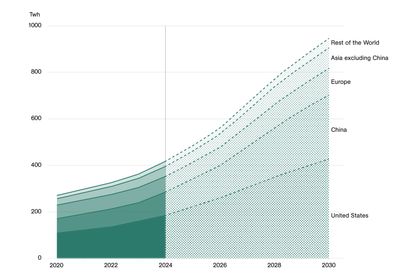
The US and China are the countries that have the highest electricity demand for data centers globally, due to their vast territories and high number of data centres.
If we change the point of view and calculate which percentage of the country’s total energy use flows through data centers, we can observe that the balance shifts towards much smaller countries such as Ireland and Switzerland.
If we consider the population factor, and look at the data centre electricity consumption per capita, the situation completely reverses. The US and China are now the smallest consumers and Ireland and Switzerland the largest.
Why are Switzerland and Ireland so attractive for data centres? Ireland is a favourable location because of its mild climate that allows the infrastructure to work on free cooling. The taxation system of this country offers low corporate taxes and data-friendly regulations.
On the other hand, Switzerland is well known for trustable data security and its biggest city, Zurich, has a high density of financial institutions. This also explains why so much of Swiss data centres are located in this region. In addition to that, there are lower cooling needs as the climate is favorable to free cooling more than 6 months a year.
SINES Data Campus: the Highest Energy Demand of a Data Centre
The most power-hungry of these machines will be the SINES Data Campus in Portugal. When completed, the campus will operate at a 1.2 GWh capacity, with a theoretical maximum annual electricity consumption of 10,512 GWh. The immense capacity of the centre is owing to its strategic location along the Atlantic Ocean, enabling fibre-optic connectivity with four continents. In comparative terms, the annual electricity consumption of the SINES Data Campus is nearly equivalent to the entire annual electricity generation of Norway.
Wired for Power: How Electricity Powers a Modern Data Center and Its Surrounding Infrastructure
Energy arrives from the public grid through overhead high-voltage lines that transition underground before reaching the site’s substation. There, transformers step the voltage down from transmission levels of around 110–220 kilovolts to medium voltage (10–20 kV) for distribution, and finally to 400 or 230 volts to supply servers, cooling systems, and IT equipment. Backup diesel generators stand ready to ensure continuity during power failures, supported by an uninterruptible power supply (UPS) and battery system that bridge the gap between main and backup power.
Inside the data centre, most of the electricity is consumed by the IT equipment—servers, storage units, and networking devices—responsible for processing and moving data. Because nearly all this energy is converted into heat, extensive cooling systems are required, typically accounting for 30–40 % of total energy use. Increasingly, data centres are reusing this waste heat to warm nearby buildings, turning an inevitable by-product into a valuable resource.
To evaluate performance, operators measure efficiency using Power Usage Effectiveness (PUE), which compares total facility energy use with the energy consumed by computing equipment. In Switzerland, the Swiss Data Center Energy Association (SDEA) provides a more comprehensive framework that tracks all energy flows to promote greater transparency and sustainability within the industry.
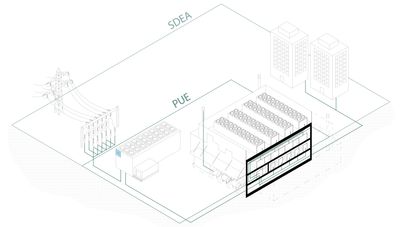
In Switzerland, 70 % of energy is imported and 30 % is produced domestically. Oil is the most commonly imported resource. Accounting for 35 % of Swiss consumption, it makes up 60 % of imports, mostly due to the transport industry. The only significant resource produced in Switzerland is electricity. More precisely, this is broken down as follows: 62 % hydropower, 29 % nuclear, 8 % solar and 1 % other renewables. As data centres consume 7 % of the country’s electricity, it is important that they are efficient in transforming this electricity into heat for neighbourhoods.
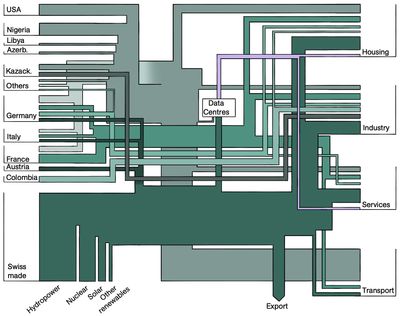
- Raw Oil
- Refined Oil
- Uran
- Wood
- Gas
- Coal
- Imported Electricity
- Produced Electricity
- Heat
A Brief History of Swiss Energy
Several important governmental and industrial events played key roles in the development of the computer, and in relation, the data centre allocation in Switzerland.
Mainframe
In 1963, as the computing industry had developed so rapidly, the university purchased a CDC 1604 mainframe and founded a new computing centre. The new machine was 400 times faster than its predecessor, and presented a pivotal moment in the rise of the computer in Switzerland.
Nuclear Power
Beznau 1 is the first commercial nuclear power reactor in Switzerland that began operations in 1969. This was the moment Swiss electricity began relying more on nuclear power as an essential energy source.
First Colocation Data Centre in Switzerland
While there is no single authoritative public source that names the “first” colocation data centre in Switzerland, the best, evidence-backed candidate for the earliest purpose- built, carrier-neutral colocation site is likely the Interxion (now Digital Realty) Zurich site in Glattbrugg–also known as ZUR1. We can see this as the rise of the data centre that started roughly in the 2000s.
CO2 Act
The Federal Act on the Reduction of CO2 Emissions (aka CO2 Act) is a Swiss federal law that regulates carbon dioxide emissions to mitigate climate change. The first CO2 Act was adopted in 1999 and came into force in 2000. The law was totally revised in 2011 and entered into force again in 2013. This represents a focus on the climate that began simultaneously with the entrance of the commercial data centre–signifying an understanding of the environmental impacts of these data centres.
Nuclear Phase-Out
Switzerland is in the process of a nuclear phase-out, which was decided in 2011 and confirmed by a 2017 referendum, after the Fukushima Power Plant Disaster. This sparked an urgency to ensure the stability and capacity of renewable energy to replace the energy supply generated by nuclear power plants.
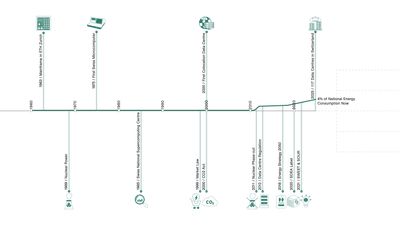
A Cautionary Projection
Mavoisin and Grande Dixence are two of Switzerland’s largest hydroelectric dams, with annual electricity yields of 1072 and 2933 GWh each, respectively. Both are within the ten tallest dams in the world, with Grande Dixence being the tallest dam in Europe. Combined, these two hydropower plants would still be just shy of the surplus electricity needed to meet the additional electricity demand of Swiss data centres in 2030.
NalpSolar is a planned photovoltaic panel farm in Tujetsch, Grisons. When completed, the 100,000 square metre facility will produce 11 GWh of electricity per year. To power Green Metro Campus’ 307 GWh annual electricity consumption alone, a solar farm with the same density as NalpSolar would need to cover nearly 3 million square metres of land. For the total additional electricity demand of data centres in Switzerland in 2030, a 37 million square metre solar farm would do the trick.
Given the enormous amount of electricity required to meet the growing energy demand of data centres, it is worth considering how this might manifest spatially. In 2030, will data centres be surrounded by photovoltaic fields, with arrays of solar panels covering the roofs, streets and lawns, dwarfing the tiny installations adorning the rooftops of centres such as Green Metro Campus? Will wind turbines scrape the Swiss sky, buffeting air warmed by data centre cooling towers?
Or will Switzerland walk back on its promises of decommissioning nuclear energy in order to appease the public, corporate, and governmental demand for more data and more artificial intelligence? Will a return to nuclear be marked by reactor towers fusing isotopes next door to data centres downloading data?
